Zoom
Trash

Differentiated Reading Instruction Worksheets and Activities. Are you a teacher who has suddenly been told that you need to “differentiate” your reading, English, or language arts instruction?

You are probably looking for worksheets and materials to help you comply with this unfamiliar concept, and I’ve got just the thing. Differentiating instruction seems challenging and overwhelming, but it doesn’t really have to be. Just follow these simple steps and use the worksheets below. You too can provide differentiated instruction in a simple and effective way. Implementation: Put students into small groups and assign them a story to read.Give each group one of these worksheets.Guide student groups as needed.Assign students another story and a different worksheet.Modify the approach as necessary and repeat.
Climax, Story Structure, and Elements of a Story Worksheet – As with all of these worksheets, this can be applied to most stories. Context Clues Vocabulary Builder Worksheet – Students select challenging vocabulary words from a text of your choosing. Leaps Teaching Social Skills. By Pam Bruening There is a lot of confusion between modification, accommodation, and differentiation, especially as these terms relate to special education.
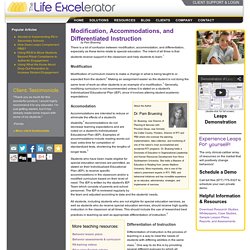
The intent of all three is that students receive support in the classroom and help students to learn.1 Modification Modification of curriculum means to make a change in what is being taught to or expected from the student.2 Making an assignment easier so the student is not doing the same level of work as other students is an example of a modification.3 Generally, modifying curriculum is not recommended unless it is stated on a student's Individualized Educational Plan (IEP), since it involves altering student academic expectations. About the Author Dr. Dr. Accomodation Accommodations are intended to reduce or eliminate the effects of a student's disability.4 Accommodations do not decrease learning expectations and are noted on a student's Individualized Educational Plan (IEP).
Follow the link and it opens . Differentiated Instruction Visually Explained for Teachers. September, 2014 Here is an interesting visual I stumbled upon today while I was browsing through my Twitter feeds.
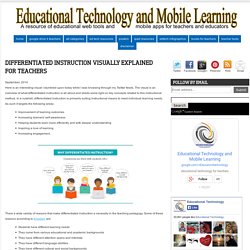
The visual is an overview of what differentiated instruction is all about and sheds some light on key concepts related to this instructional method. In a nutshell, differentiated instruction is primarily suiting instructional means to meet individual learning needs. As such it targets the following areas: Improvement of learning outcomesIncreasing learners' self-awarenessHelping students learn more efficiently and with deeper understandingInspiring a love of learningIncreasing engagement.
Leaps Teaching Social Skills. 4 Ways to Differentiate Objectives. Photo by Waisian … a differentiated classroom provides different avenues to acquiring content, to processing or making sense of ideas, and to developing products.”
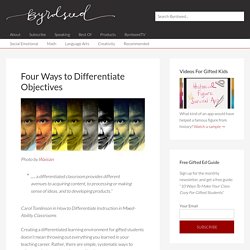
Carol Tomlinson in How to Differentiate Instruction in Mixed-Ability Classrooms Creating a differentiated learning environment for gifted students doesn’t mean throwing out everything you learned in your teaching career. Rather, there are simple, systematic ways to adjust curriculum to benefit your gifted learners. More about these four ways can be found in Kaplan & Gould’s The Flip Book and Flip Book, Too. A Teacher's Guide to Differentiating Instruction. Introduction Does effectively teaching 30 students in one classroom require teachers to develop 30 lessons, one tailor-made for each student?
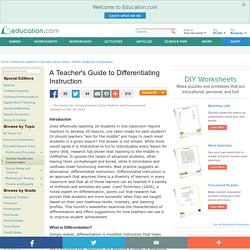
Or should teachers “aim for the middle” and hope to reach most students in a given lesson? The answer is not simple. While most would agree it is impractical to try to individualize every lesson for every child, research has shown that teaching to the middle is ineffective. It ignores the needs of advanced students, often leaving them unchallenged and bored, while it intimidates and confuses lower functioning learners. What is Differentiation? Simply stated, differentiation is modified instruction that helps students with diverse academic needs and learning styles master the same challenging academic content. How to Start Four planning steps set the stage for effective differentiated instruction. Vary Materials Nonfiction and fiction, written at a variety of reading levels. Vary Process Vary Assessment Conclusion References Good, M. View Full Article. Differentiated Instruction for English Language Learners. Home > ELL Topics from A to Z > Differentiated Instruction for English Language Learners By: Karen Ford (2011) Each student comes to school, not only with unique academic needs, but also with unique background experiences, culture, language, personality, interests, and attitudes toward learning.
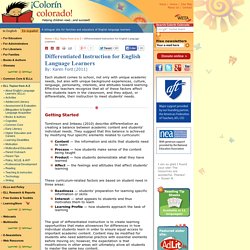
Effective teachers recognize that all of these factors affect how students learn in the classroom, and they adjust, or differentiate, their instruction to meet students' needs. Getting Started Tomlinson and Imbeau (2010) describe differentiation as creating a balance between academic content and students' individual needs. How to Make a Rubric for Differentiation. Rubrics are "rules" or a way to explicitly lay out expectations for an assignment, and the means to evaluate or grade an assignment using a point system.
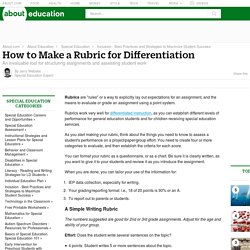
Rubrics work very well for differentiated instruction, as you can establish different levels of performance for general education students and for children receiving special education services. As you start making your rubric, think about the things you need to know to assess a student's performance on a project/paper/group effort. You need to create four or more categories to evaluate, and then establish the criteria for each score. You can format your rubric as a questionnaire, or as a chart. Be sure it is clearly written, as you want to give it to your students and review it as you introduce the assignment. Differentiating Instruction. Differentiated Instruction Resources. Differentiated Instruction. Inclusion and Differentiated Instruction: Teachers in the Movies do it Too.
Classroom Showdown: Traditional vs Differentiated. What is Differentiated Instruction? Tips & Strategies for Effective Differentiation & Instruction.wmv. How to Differentiate Instruction in Mixed-Ability Classrooms. What Differentiated Instruction Is And Isn't Kids of the same age aren't all alike when it comes to learning, any more than they are alike in terms of size, hobbies, personality, or likes and dislikes.
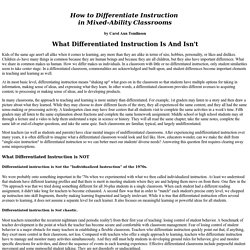
Children do have many things in common because they are human beings and because they are all children, but they also have important differences. What we share in common makes us human. How we differ makes us individuals. And Is Not: The Definition Of Differentiated Instruction. What Differentiation Is–And Is Not: The Definition Of Differentiation by TeachThought Staff For teacher’s and administrators, a useful definition of differentiated instruction is “adapting content, process, or product” according to a specific student’s “readiness, interest, and learning profile.”
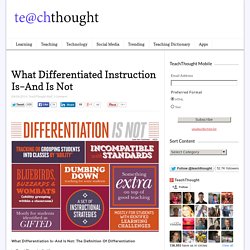
It can be first that of as a matter of contrast–“differences.” This student needs something different than that in pursuit of a given learning goal. Differentiated Instruction in the Adult Education Classroom - April 9 & 10, 2015. Brain Research confirms what wise and experienced teachers have always known: No two brains are alike; therefore, no two students are alike.
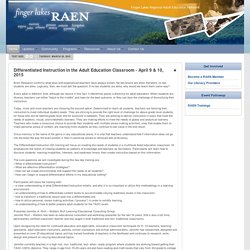
Logically, then, we must ask the question: If no two students are alike, why would we teach them same way? Every adult is different. Pros and Cons of Differentiated Instruction. Maybe you have heard of differentiated instruction but don’t quite know what it is. Differentiated instruction is a way of teaching which looks at each individual student in the classroom, and tries to personalize instruction for each individual.
That means stepping away from teaching in a classroom in only one way, and incorporating different things for different learning styles and personalities. The Pros of Differentiated Instruction 1. Each Child is Taught to Their Learning Style That means that children who learn better with hands on lessons may do more with math manipulatives and less with flash cards or worksheets, for example. 2. 3. 4. 5. The Cons of Differentiated Instruction 1. 2. 3. 4. 6 Steps to Differentiated Instruction. At the beginning of my teaching career I believed that effective differentiation consisted of sitting students in ability groups and producing three different level worksheets for each lesson.
I soon began to realize that this could produce a self fulfilling prophecy in students, believing that whichever group or worksheet they were assigned defined them as a student. Even the parents were aware of who was on the “top” or “bottom” table. I felt very uncomfortable with this labeling of children so young and began to research and experiment with a range of strategies to ensure all children are challenged and taught at an appropriate level. It often feels like spinning plates in the classroom, but these ideas have really helped to ensure that all students make accelerated progress without feeling disillusioned.
Sometimes I differentiate by ability, by social skills, or by confidence in performing. Making Small Groups Work for Differentiated Instruction. Note: On February 17, Dr. Vicki Gibson, a national education consultant, author, speaker and trainer, will lead a McGraw-Hill Education webinar titled “Classroom Management for Differentiating Instruction and Collaborative Practice.” The session will provide solutions for the challenges that many teachers experience when providing students with differentiated instruction using a small-group approach. In this post, Dr. Gibson previews the discussion. More than 30 years of research has proven that working with students in small groups works best to enhance learning and achievement. Differentiated Instruction Works: How and Why to Do DI. Differentiated instruction is an approach to teaching in which educators actively plan and adjust for students’ differences so that instruction suits and supports all students’ strengths and needs.
It is the process of ensuring that what a student learns, how he or she learns it, and how the student demonstrates what he or she has learned is a match for that student’s readiness level, interests, and preferred mode of learning. There can be differentiation of content, process, product, and learning environment. Technology Articles. Differentiated Instruction. What Is Differentiated Instruction? What Is Differentiated Instruction? This article was excerpted from the Scholastic Professional title, Differentiating Reading Instruction, by Laura Robb. Differentiation is a way of teaching; it’s not a program or package of worksheets. It asks teachers to know their students well so they can provide each one with experiences and tasks that will improve learning. As Carol Ann Tomlinson has said, differentiation means giving students multiple options for taking in information (1999).
Differentiated Instruction - Videos, Articles, Resources, Experts. Blogs on Differentiated Instruction.